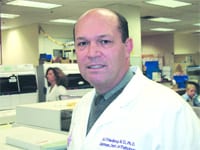‘That’s Somebody’s Life’ Laboratory Technicians Work at the Junction of Medicine and Science
Standing at one end of the headquarters of Baystate Reference Laboratories, Dr. Richard Friedberg compared the hum of activity — seemingly chaotic, but actually intricately organized — to a beehive.
It’s certainly as productive as one. And it can sometimes feel as tightly packed.
“There’s a lot more we could do if we had the right amount of space and resources,” said Friedberg, Baystate’s chair of Pathology. “But as in any system, we’ve got a limited number of resources, and we’ve got demands and expectations like everyone else.”
However, he was quick to note, “everything runs off of what we generate. You can pull the cardiologists out of the hospital, and the kidney guys might not notice. And if you took out the kidney guys, the lung guys might not notice. But if you crippled the lab, everybody would notice. We really are the foundation of the diagnoses and processes here. A hospital can’t be any better than the laboratory is.”
That’s because some 80{06cf2b9696b159f874511d23dbc893eb1ac83014175ed30550cfff22781411e5} of the patients who come through the hospital doors eventually have a part of their diagnosis or treatment filter through the lab — some 5 to 6 million tests annually, in all. That includes some 45,000 to 50,000 surgical cases per year and more than 90,000 pap smears.
That makes the laboratory a kind of Grand Central Station for much of the information doctors need at the bedside or on the operating table. That’s why it’s important that the trains, so to speak, keep humming along on time.
Feeling the Heat
Although a nationwide shortage of laboratory technicians has strained labs everywhere, Baystate has managed to maintain what is easily the region’s largest such network, with 26 satellite patient centers located throughout Western Mass., about as many vehicles, and more than 40 couriers to deliver specimens.
The physicians at Baystate Pathology, the group practice that oversees the lab network, also take specimens from more than 700 private physician practices in the region.
Friedberg said the vast majority of Baystate’s lab technicians have at least a bachelor’s degree. And most have an inclination toward — and previous education in — some kind of science, be it biology, chemistry, or engineering.
“Some people are more attracted to dealing directly with patients,” he said, and they tend to be drawn to fields like nursing. “Others are more fascinated by the diagnostic side, the scientific side — the laboratory side.”
That’s long been the case, he said, but the nature of laboratory work, and the skills required for it, have changed at a much more rapid pace than in nursing.
Despite the excitement and challenge of lab work, however, “medical technologists are a difficult breed to recruit,” Friedberg said. “It takes somebody early on who wants in undergoing the training. Many of them take the same courses that biology and pre-med majors do, and then, depending on which area of the lab they want to focus on, they can take different paths. Some people are specialists in chemistry, or microbiology, or cytology.”
Still, the appeal goes beyond science; at its heart, it’s a very human field, Friedberg said. That’s because, despite the fact that laboratory might not be considered a ‘hands-on’ health career in the sense of touching and talking to patients, when technicians at Baystate run one of those millions of tests or produce one of some 45,000 slides a month, they understand completely that they’re holding a life on that dish or slide.
“That’s somebody’s life there,” Friedberg said. “The technicians understand — but we drive it home — that anything we put out can change somebody’s life, sometimes for the better and sometimes for the worse. It’s a reality that we deal with, and it’s an impressive role that sometimes patients don’t see.”
For example, he noted that on TV shows like ER and House, viewers might see a surgeon looking into a microscope and making a diagnosis himself based on what he sees.
“That never happens. The world is not like that,” Friedberg said. “We’re the ones who are at the junction of medicine and science.”
Making a Name
To make it all work, Baystate boasts more than half of all the practicing pathologists in Western Mass.
“On the national scene, this department is quite prominent,” Friedberg noted, pointing to a bulletin board completely covered with journal articles written by Baystate pathologists; the department produced 30 peer-reviewed articles last year alone, as well as a handful of textbook chapters. Several of the doctors serve on prominent pathology boards, and two are presidents of national societies. “Clearly, we’re better known in our field across the country than we are in Western Mass.”
Baystate has been able to use that success and recognition in its recruiting efforts, a job that is never done — especially with a massive hospital expansion launching soon. But Friedberg said the nature of the job itself is an effective enticement for many.
“This is a way to be involved, a way to make a difference,” he said, adding that the lab, being operative 24 hours a day, every day, offers hours to suit just about anyone’s lifestyle. State-of-the-art, automated specimen analyzers perform blood counts and other tests, cutting the time required for those jobs by two-thirds, Friedberg said — but the most important tools in the lab remain the eyes and minds of its technicians and pathologists.
The work is collaborative — any abnormal result gets bumped up to a more senior employee, and the microscopes are engineered for two people to look at a slide at once. Again, that speaks to the importance of getting it right.
“We can diagnose things earlier than ever, and that’s a cost savings for the system,” Friedberg said. But more importantly, “would you rather have a small procedure today or a major procedure or chemotherapy two years from now? Most would rather get it done now, when the chance for a cure is better.”



Comments are closed.